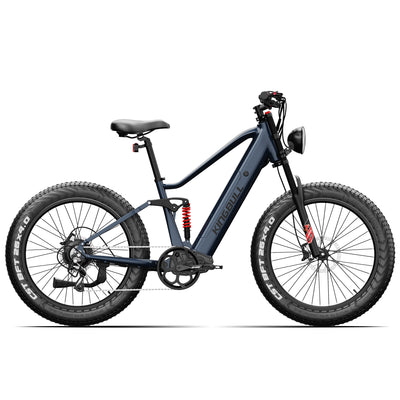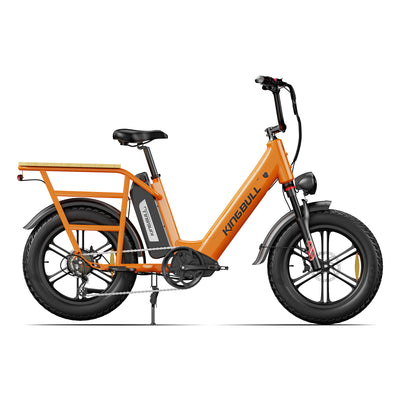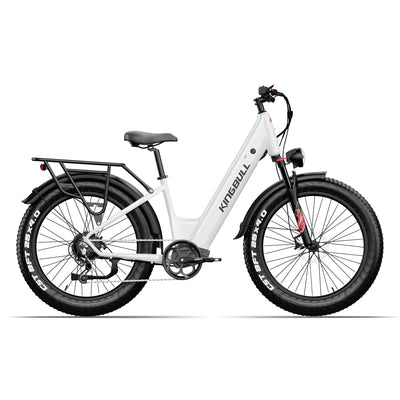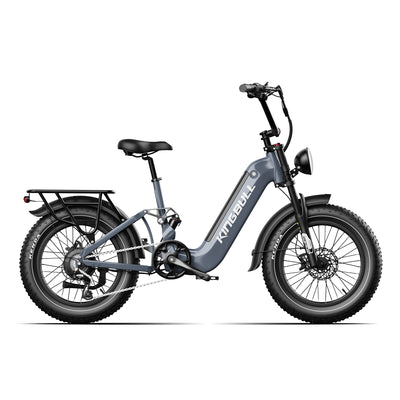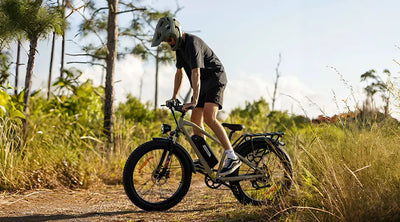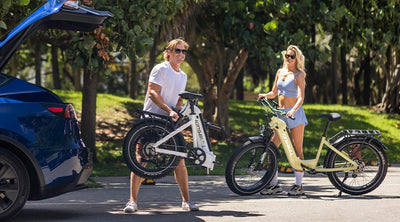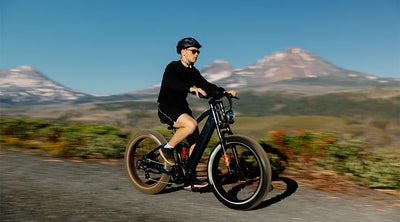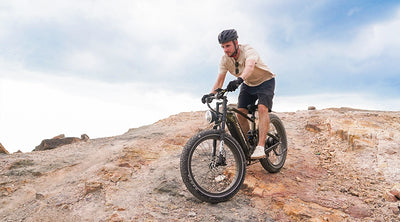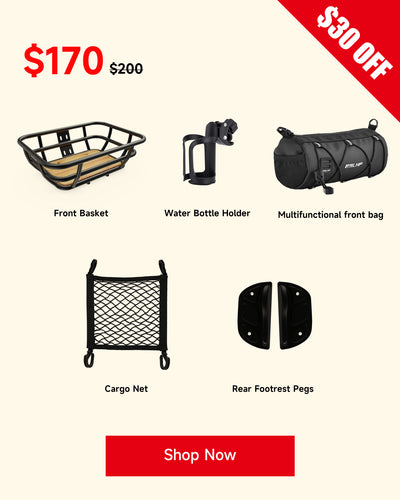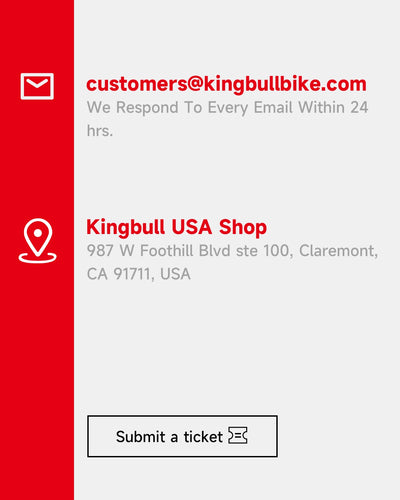Explore News

Maintenance
How to Install an External Battery on Your Voyager 2.0: A Step-by-Step Guide
If you love your Voyager 2.0 e-bike but wish you could go farther on a single charge, this guide is for you. Installing an external battery is one of the easiest and most effective upgrades you can make to extend your e-bike’s range and enjoy longer rides without worrying about running out of power.
Follow this simple, step-by-step tutorial to learn how to install an external battery on your Voyager 2.0 safely and efficiently.
🧰 What You’ll Need
Before you begin, make sure you have:
A King Bull Toolkit (or a standard bike repair toolset)
Your external battery pack
A battery combiner cable
⚙️ Step 1: Remove the Seat
Start by loosening the quick-release clamp underneath your seat. Once it’s loose, remove the seat completely to access the controller area of your Voyager 2.0.
⚡ Step 2: Open the Controller Box
Use your toolkit to loosen the screws on the controller box. Open the cover and carefully remove the controller.You’ll see the internal battery connection — disconnect it gently to prepare for the external battery setup.
🔌 Step 3: Connect the Battery Combiner
Now, take your battery combiner, which includes three wires:
Connect the black connector wire to the controller.
Connect the other two wires to your internal and external batteries — it doesn’t matter which one goes where.
Once everything is connected, place the controller and combiner back into the controller box. Then, feed the remaining wire through the small opening in your bike’s frame.
🔩 Step 4: Install the Battery Base
Next, prepare the battery base.
Loosen the screws on the base and position it along the Voyager 2.0 frame.
Connect the wire from the battery base to the battery combiner.
Once aligned, secure the base firmly with four screws, just like in the demo video.
This will ensure the battery stays stable even on bumpy rides.
🔋 Step 5: Mount the External Battery
With the base in place, carefully mount your external battery onto it.Turn on the battery switch to check if it’s working properly and providing power to your system.
✅ Step 6: Reassemble and Test
Reinstall your seat and tighten the controller box screws.Double-check all the connections and make sure every screw is secure. Then, power on your Voyager 2.0 and confirm that both batteries are working together.
🚴 Enjoy Longer Rides with Dual Batteries
Congratulations! You’ve successfully installed an external battery on your Voyager 2.0 e-bike.With this dual-battery setup, you’ll enjoy extended range, more riding time, and less charging downtime. Perfect for long commutes, weekend adventures, or just exploring farther than ever before.
Read more
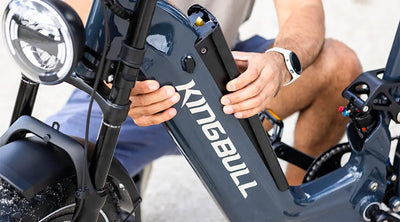
Maintenance
Complete E-Bike Maintenance Guide: Keep Your Electric Bike Like New
Why E-Bike Maintenance Matters
Electric bikes are sophisticated machines that require proper care to ensure optimal performance, safety, and longevity. Regular maintenance not only extends your e-bike's lifespan but also keeps you safe on the road.
Battery Care
Charging Best Practices
Always use the original charger provided by the manufacturer
Avoid overcharging - unplug when fully charged
Charge when battery reaches 50-70% capacity
Avoid charging in extreme temperatures (below 32°F or above 104°F)
If storing long-term, charge at least once per month
Battery Storage
Store in a cool, dry place away from direct sunlight
Maintain 50% charge level for long-term storage
Remove battery if storing bike for extended periods
Check battery connections regularly for corrosion
Mechanical Components
Chain Maintenance
Clean chain every 100-200 miles or after wet rides
Use a dedicated chain cleaner and degreaser
Apply chain lubricant after cleaning
Check chain tension and adjust as needed
Replace chain when stretched beyond manufacturer specs
Brake System
Inspect brake pads for wear regularly
Adjust brake cable tension as needed
Keep brake rotors clean and free from oil
Test brake function before each ride
Replace brake pads when worn to minimum thickness
Tire Care
Check tire pressure weekly (refer to sidewall for PSI)
Inspect for cuts, punctures, or excessive wear
Remove debris stuck in tread
Replace tires when tread depth is insufficient
Rotate tires if wear pattern is uneven
Electrical System
Controller and Display
Keep electrical components dry and clean
Check all connections for looseness or corrosion
Clean display screen with soft, dry cloth
Address error codes immediately
Protect from water during cleaning
Motor Maintenance
Keep motor housing clean and dry
Avoid riding through deep water
Check motor mounting bolts for tightness
Listen for unusual noises during operation
Have motor serviced if overheating occurs
Daily Riding Tips
Good Riding Habits
Start pedaling before engaging motor assistance
Use appropriate assist levels for terrain
Avoid sudden acceleration and hard braking
Don't exceed maximum weight capacity
Clean bike after riding in wet conditions
Storage Recommendations
Store in a covered, secure location
Use a bike cover for outdoor storage
Avoid leaving in direct sunlight for extended periods
Rotate bike position occasionally to prevent tire flat spots
Troubleshooting Common Issues
Reduced Range
Check battery health and age
Verify proper tire pressure
Assess riding conditions and habits
Consider battery replacement if significantly degraded
Unusual Noises
Check chain lubrication and alignment
Inspect brake pad position
Examine wheel bearings
Listen to motor operation
Electrical Problems
Check all connections
Verify battery charge and condition
Reset system if applicable
Consult manual for error codes
Professional Service: For complex issues or if you're uncomfortable performing maintenance, visit a qualified e-bike technician. At Kingbull Bikes, we offer comprehensive e-bike maintenance and repair services to keep your ride in perfect condition!
Read more

Maintenance
Beat the Heat: Your Essential Guide to Summer E-Bike Riding
Summer's officially here, and you know what that means: longer days, epic rides, and the perfect excuse to hit the trails on your e-bike! But as the temperatures crank up, a little extra love for your ride (and yourself!) goes a long way. This guide's packed with useful tips to keep you cruising safely and your e-bike humming happily all season long.
1. Before You Ride: Prep Yourself & Your Bike for the Heat
Personal Prep:
Lightweight, Breathable Gear: Opt for light-colored, moisture-wicking fabrics (like athletic quick-dry wear) to reflect sun and keep you cool.
Sun Protection is Key: Apply high-SPF sunscreen, wear UV-protective sunglasses, and consider a wide-brimmed hat (helmet-compatible) or neck gaiter for extra coverage.
Ventilated Helmet: Choose a helmet with ample vents to ensure proper airflow and head cooling.
Hydrate, Hydrate, Hydrate: Drink plenty of water before, during, and after your ride. Don't wait until you're thirsty—that's already a sign of dehydration. Carry plenty of water, ideally in an insulated bottle to keep it cool. For longer rides, plan out water stops.
Bike Check:
Tires:
Tire Pressure: High temperatures can increase tire pressure. Always use a tire gauge to check pressure before riding, adjusting to the recommended range (usually 25-30 PSI, check your bike's manual or tire sidewall). Over-inflated tires risk blowouts, while under-inflated ones can lead to flats and reduced efficiency.
Tread & Debris: Inspect the tire surface for cracks, bulges, or excessive wear (where wear indicators are visible). Remove any embedded stones, glass, or debris from the tire treads to prevent punctures during your ride.
Brakes:
Brake Feel: Squeeze the brake levers to check for responsiveness and firm return. They should feel consistent and strong.
Pad Wear: Inspect brake pad thickness (for both disc and V-brakes). If they're worn down or making screeching noises, replace them promptly. For disc brakes, check rotors for warping or oil residue.
Cables/Hoses: Look for any signs of rust or stickiness in brake cables, and check hydraulic brake lines for leaks.
Battery:
Visual Check: Inspect the battery pack for any damage, swelling, or leaks. Ensure it's securely mounted to the bike frame.
Charge Level: Confirm you have enough charge for your planned ride. Avoid riding long distances on a very low battery, as this can strain it.
Connectors: Check that battery terminals and charging ports are clean and dry, free of debris.
2. During Your Ride: Ride Smart, Stay Safe
Avoid Peak Heat Hours: Whenever possible, ride during cooler times of the day, like early mornings, evenings, or after sunset. Try to avoid the hottest hours between 10 AM and 4 PM. If you must ride in the heat, plan for more frequent, longer breaks in shady spots.
Use That Assist Wisely: Take advantage of your e-bike's power assist. In hot weather, use higher assist levels to reduce your physical exertion, keeping your body cooler. Avoid prolonged high-intensity riding, which can overheat the motor and battery. If you notice them getting too hot, stop and let them cool down.
Watch the Road: Pavement can get extremely hot in summer, potentially affecting tire softness or grip. Be extra cautious on wet spots (like freshly watered roads or post-rain puddles), especially when turning. Choose routes with more tree cover to avoid constant direct sunlight on asphalt.
Listen to Your Body: If you feel dizzy, nauseous, rapid heartbeat, extreme fatigue, or muscle cramps—these are signs of heatstroke. Stop immediately, rest in a cool, shady spot, and rehydrate (ideally with electrolyte drinks). Seek help if symptoms persist.
3. After Your Ride: Post-Ride Care for Longevity
Battery Care:
Cool Before Charging: Don't charge your battery immediately after a ride, especially if it's warm. Park your e-bike in a cool, well-ventilated area and let the battery cool down naturally (usually 30-60 minutes, depending on ride intensity).
Safe Charging Environment: Always use the original charger in a dry, well-ventilated area away from direct sunlight and flammable materials. Avoid charging in enclosed, hot spaces.
Avoid Overcharging/Over-discharging: Disconnect the charger once the battery is full; avoid leaving it plugged in overnight. Similarly, try not to drain the battery completely; keeping it between 20-80% charge generally extends its lifespan.
Long-Term Storage: If storing your e-bike for an extended period, remove the battery (if removable) and keep it in a cool, dry, well-ventilated place with a 50-80% charge. Check the charge monthly.
Tire & Brake Care:
Tires: Clear any dirt, mud, or small stones from the tire treads. If storing long-term, avoid putting constant pressure on one part of the tire; slightly over-inflate or rotate the wheels regularly to prevent flat spots.
Brakes: Keep brake pads and rotors (for disc brakes) clean from oil and dust, which can affect performance. If rotors are oily, clean them with a specialized brake cleaner. Regularly check brake cable tension or hydraulic fluid levels.
General Cleaning & Maintenance:
Summer can mean more rain or dust. Clean your e-bike promptly after rides, paying special attention to the chain, gears, and other drivetrain components, then lubricate the chain.
Avoid using high-pressure washers directly on the battery, motor, or other electrical components. Use a damp cloth for cleaning, and specialized bike cleaners when necessary.
When to Consult Professionals for E-Bike Maintenance
Knowing when to call in the pros for e-bike maintenance is crucial for keeping your ride safe and performing its best. Here's when to reach out:
Strange Noises: Hearing grinding or clicking sounds? These often signal deeper mechanical issues that need expert attention.
Brake Issues: Even after regular home upkeep, if your brakes don't feel right, have a technician inspect them. Your safety on the road is paramount.
Electrical Hiccups: If you're experiencing inconsistent power, unresponsive controls, or any other electrical problems, reach out to us immediately at customers@kingbullbike.com for dedicated support.
Summer Fun Awaits: Ride On, Worry-Free!
So there you have it! Summer e-biking is all about soaking up those rays and hitting the trails. By giving your e-bike (and yourself!) a little extra love with these simple tips, you'll keep everything running smoothly even when the mercury rises. Think of it as tuning up your ride for maximum fun and minimum fuss. Now go out there, embrace the sunshine, and make some awesome summer memories on two wheels. Stay cool, ride safe, and enjoy every single mile!
Read more
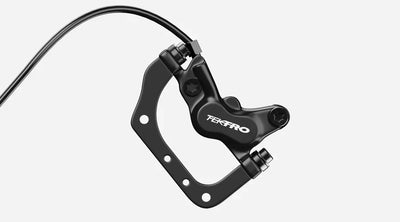
Maintenance
How to Make Your E-Bike Disc Brakes Last Longer
With the growing popularity of electric bikes, more riders are realizing the importance of braking safety. Whether you're commuting daily or cruising on the weekend, your e-bike's disc brakes play a critical role in your ride experience. But how much do you actually know about them?
Let’s dive into the basics of disc brakes, common issues you may face, and some practical tips to make your e-bike braking system last longer and perform better.
What Are Disc Brakes?
Disc brakes work by using brake pads to squeeze a rotor (disc) attached to your wheel. This friction slows the wheel down. There are two main types used in e-bikes:
1. Hydraulic Disc Brakes
Use brake fluid to transfer force.
Offer strong stopping power with minimal effort.
Great for performance and steep terrains.
Downside: More complex and requires regular maintenance to prevent leaks and keep the seals in good condition.
2. Mechanical (Cable-Pull) Disc Brakes
Use a brake cable to apply pressure on the disc.
Easier to maintain and more budget-friendly.
Suitable for city commuters and casual riders.
Downside: Can lose braking power over time due to cable stretch or friction in the cable housing.
🔍 Common Disc Brake Problems on E-Bikes
Even with regular use, disc brakes can develop issues. Here are three of the most common problems and how to fix them:
1. Brakes Feel Too Tight or Too Loose
If your brakes feel sticky or don't engage at all, the brake cable tension is likely off.
Fix: Adjust the tension knob near the brake lever.
Turn counterclockwise to tighten.
Turn clockwise to loosen.
2. Squeaky or Rubbing Brakes
This usually happens when:
The brake rotor is misaligned.
The rotor is warped due to impact or heat.
Fix: Adjust the rotor position with the mounting screws. If the disc is warped, replace it to prevent damage to other parts.
3. Weak or No Braking After a While
This is often caused by worn brake pads or stretched brake cables.
Fix: Check the pads and cables for wear and replace them as needed. Brake pads usually last between 6 months to 1 year depending on usage.
How to Maintain Your E-Bike Disc Brakes
Here’s how to keep your disc brakes in top shape and extend their lifespan:
✅ 1. Ride Smoothly – Avoid Sudden Braking
Avoid aggressive braking unless absolutely necessary. Hard braking can:
Lock the wheels and cause you to lose balance.
Wear out brake pads faster.
Overheat or warp the rotor.
Train yourself to brake gradually and anticipate stops ahead of time.
✅ 2. Regularly Inspect Brake Pads & Cables
Check your brake pads at least every 3–6 months.
Replace them when they become thin or glazed.
Inspect cables for rust, fraying, or reduced tension.
✅ 3. Protect the Brake Rotors
Keep the rotors clean and free from dirt or oil.
Avoid impacts that can bend or warp the disc.
If using mechanical brakes, keep cables well-lubricated to reduce friction and maintain responsiveness.
Final Thoughts
Disc brakes are a key safety feature for any electric bike. Whether you’re riding through city traffic or down a country trail, proper brake maintenance ensures both safety and performance. Follow these tips to keep your system reliable—and make your e-bike experience smoother and safer every time you ride.
Read more
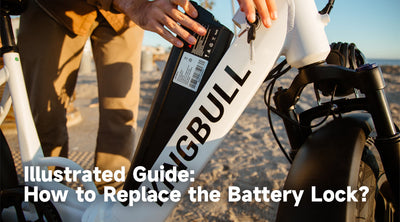
Maintenance
Lost or Broken Battery Lock Key? Here’s What to Do
Hey, Kingbull bike riders! We’re constantly striving to ensure you enjoy an outstanding riding experience. Lately, we’ve realized that many of you encounter a common issue: losing the key to your battery lock or having it break during rides. This not only disrupts your journey but can also lead to avoidable headaches. At Kingbull, we understand your frustration all too well. That’s why we’ve come up with multiple solutions. Our aim? To help you get back on track quickly!
Proactive Prevention: Secure a Spare Key
To avoid the inconvenience caused by losing the key, we strongly recommend that you immediately store a spare key properly upon receiving the bike. In this way, even if the main key is lost or damaged, you can handle the situation easily and ensure a worry - free ride.
What should you do if the key is lost or damaged?
Don't worry. Kingbull provides two solutions to help you quickly resume using the battery:
1.Purchase a Brand New Battery Lock and Key (Officially Recommended)
If you've lost all the keys, or you wish to replace the existing lock, the most reliable solution is to directly replace the battery lock and key with a new set. You can easily order a lock that is compatible with your bike model on the official Kingbull website, ensuring both security and compatibility. The installation process is simple, enabling you to get back to riding quickly!
Steps for Replacing the Battery Lock
If you need to replace the battery lock, you can follow these steps:
Step 1: Remove the Battery Take the battery out of the bike body
Step 2: Remove Screws on the Battery Upper Base
After removing the battery, unscrew the screws in the area circled in red on the battery's upper base.
Step 3: Detach the Complete Battery Base
Unscrew the screws on the side of the bike that fasten the battery lock. This allows you to remove the entire battery base. After removal, attach the new lock to the base in the correct manner. Finally, reinstall the assembled unit back onto the bike.
Step 4: Tighten the Screws
Tighten the screws on the battery upper base and those on the side of the bike.
2.Get a Spare Key Made at a Local Hardware Store (Quick Fix)
If you still have one key in hand, head to a nearby hardware store or key - cutting shop to get a copy made. This is the quickest and most cost - effective solution. It enables you to resume using your bike right away without having to replace the entire lock set.
Stay Ready, Ride Worry-Free!
Losing or damaging your battery key can be frustrating, but with these simple solutions, you’ll be back on the road in no time. Remember to keep your spare key safe to avoid unnecessary trouble. Stay prepared, ride with confidence, and enjoy every journey with your Kingbull e-bike!
Read more
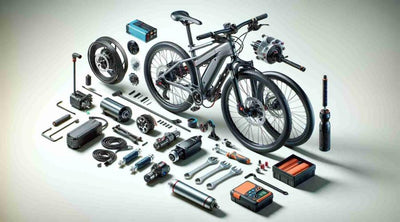
Maintenance
How To Troubleshoot An Electric Bike?
"Discover the secrets to maintaining your electric bike with our troubleshooting guide. From diagnosing power and battery issues to tackling electrical and mechanical problems, we'll walk you through step-by-step solutions. Save time and money while gaining a deeper understanding of your e-bike's inner workings for uninterrupted rides ahead."
The ability to troubleshoot an electric bike is a valuable skill for any e-bike owner. Mastering e-bike troubleshooting saves time, money, and hassle. Gain a deeper understanding of your bike's mechanics and make informed decisions when seeking help.Keep reading to learn how to identify and solve electric bike problems step by step. With our guidance, keep your journey smooth and uninterrupted.
Understanding Common Electric Bike Issues
Despite their efficiency and enjoyment, electric bikes can encounter common technical issues. Below are these issues with their symptoms, causes, and potential solutions
Power and Battery Problems
1.Battery not charging or holding a charge. If your electric bike battery is not charging or holding a charge, check the battery connections to make sure they’re secure and free from corrosion. If everything appears to be in order, try charging the battery using a different charger or power source to rule out any faults with the charging equipment. If the battery still does not charge, you may need to inspect the battery cells for any signs of damage or wear.
2.Sudden power loss during rides. Experiencing a sudden power loss during an e-bike ride can be alarming, but there are a few steps you can take to address the issue. First, check the battery charge level, to ensure it hasn't depleted completely. If the battery charge is low, switch to a lower power assist mode or pedal without assistance to conserve the remaining power. If none of this helps, consider manually pedaling the bike to reach your destination. Then seek assistance from an e-bike technician to diagnose and resolve the power loss issue.
3.Inconsistent or weak motor assistance. If you're experiencing inconsistent or weak motor assistance on your electric bike, there are a few troubleshooting steps you can take to address the issue. First, check the battery charge level to ensure it's adequately charged. You should also examine the motor cables and connections to ensure they’re securely attached and free from damage or corrosion. If everything appears to be in order, review your e-bike's settings and make sure the power assist mode is properly adjusted to your desired level.
Electrical System and Wiring
1.Malfunctioning display or controls. The first thing to do when faced with a malfunctioning display or controls is to check the connections between the display/control unit and the wiring harness to make sure they’re secure. If the connections are intact, try resetting the display/control unit by turning off the bike and disconnecting the battery for a few minutes before reconnecting it. If the problem persists, check if the display/control unit has any error codes or error messages, as they can provide clues about the underlying issue.
2.Loose or damaged wiring connections. If you're experiencing loose or damaged wiring connections, carefully inspect the wiring connections, looking for any signs of loose or disconnected wires, frayed insulation, or damaged connectors. If you find any issues, gently reconnect or tighten the loose connections and secure them properly. In the case of damaged wiring, it's best to replace the affected sections with new wires of the appropriate gauge and insulation. If you're unsure about handling electrical repairs, seek help from a qualified technician or bike shop.3.Issues with lights or other electrical components. When it comes to issues related to lights or other electrical components, it’s vital to start by checking the connections between the affected components and the main wiring harness to ensure they’re securely attached. If the connections are secure, inspect the components themselves for any signs of damage, such as loose bulbs or cracked casings. Replace any faulty bulbs or damaged components with compatible replacements. If the problem persists, check the fuse for the lighting system and replace it if necessary. It's also a good idea to test the electrical system using a multimeter to ensure the proper voltage is reaching the components.
Mechanical and Performance Issues
1.Braking problems or unusual noise. Braking problems or unusual noises can put a damper on your electric bike ride, but fear not! There are steps you can take to tackle these issues and get back to enjoying smooth, quiet rides. First, check the brake pads for wear and tear, ensuring they have sufficient thickness and are properly aligned with the brake discs. If necessary, replace the brake pads with new ones. Next, examine the brake cables for any signs of fraying or stretching, and adjust or replace them if needed. It's also crucial to inspect the brake calipers and discs for any damage or warping, as this can affect braking performance and create unwanted noise.
2.Shifting difficulties or chain slipping. If facing gear shifting difficulties or chain slipping, first check the cable tension to make sure it's properly adjusted. A simple tweak might be all it takes to restore seamless shifting. Next, inspect the derailleur and jockey wheels for any debris or signs of wear. Cleaning and lubricating these components can work wonders in improving shifting performance.3.Unbalanced or wobbly wheels. Are your electric bike wheels feeling a bit wobbly or unbalanced? First things first, check the spoke tension to make sure they're properly tightened. A quick adjustment with a spoke wrench might be all it takes to straighten things out. Next, inspect the rims for any dents or damage that could be causing the wobbling. If you find any issues, it might be time to replace the rim or seek professional help. Don't forget to check the tire pressure to make sure it's at the recommended level for a firm grip on the road.
Troubleshooting Steps and Solutions
Preparing for Troubleshooting
1.Safety precautions and equipment needed. Before you start troubleshooting anything, it's essential to gear up and prioritize safety and make sure you have the right safety equipment on hand. This includes safety glasses, and gloves.Arm yourself with a toolkit containing essentials like screwdrivers, wrenches, pliers, and a multimeter to help you diagnose those mysteries lurking in your e-bike's electrical realm.2.Familiarizing yourself with the bike's manual. The bike's manual is a valuable resource that holds the key to unlocking a deeper understanding of your electric bike. Take the time to read through it thoroughly, paying attention to sections that cover important topics such as operation, maintenance, troubleshooting, and safety guidelines.
Basic Checks and Inspections
1.Ensuring power source and connections. Start by verifying the battery's secure connection and full charge. Check for loose cables or corrosion on battery terminals, ensuring tight and clean connections. Next, inspect wiring between the battery, motor, and controller for secure, undamaged connections. Take time to check power switches and buttons for proper function and responsiveness. Additionally, watch for any visible wear or damage on power cables and replace them if needed. 2.Assessing battery health and charge levels. check for physical damage, swelling, or leaks. Use the bike's built-in battery indicator or a multimeter to measure voltage if not available. Compare readings to manufacturer specs and consider battery age, which can affect capacity. 3.Examining tires, brakes, and drivetrain components. Start by inspecting the tires for any signs of wear, cuts, or punctures. Make sure they’re properly inflated to the recommended pressure for a smooth and comfortable ride. Moving on to the brakes, check the brake pads for wear and replace them if they’re worn down. Test the brake levers to ensure they engage smoothly and provide sufficient stopping power. Next, examine the drivetrain components, including the chain, cassette, and derailleurs. Look for signs of rust, dirt buildup, or stretched chain links. Clean and lubricate the chain regularly, and consider replacing it if it's excessively worn. Check the shifting performance, ensuring smooth and precise gear changes.
Troubleshooting Specific Issues
Step-by-step instructions for common problems.Following step-by-step instructions for common problems is a smart and efficient approach to troubleshooting your electric bike. These instructions are often provided by the manufacturer.
Electrical System Repairs and Wiring Fixes
1.Identifying and repairing loose or damaged connections. Loose or damaged connections can cause various issues, such as intermittent power loss, malfunctioning components, or unreliable performance. To identify loose connections, carefully inspect all wiring connections throughout the electrical system, paying close attention to plugs, terminals, and junctions. Look for any signs of looseness, corrosion, or frayed wires. Repairing loose connections involves securely reconnecting or tightening the affected components, ensuring a snug and reliable fit. For damaged connections, such as broken wires or connectors, consider replacing the damaged parts with new ones or using electrical tape or connectors to repair the damage.
2.Replacing faulty electrical components if necessary. If you encounter faulty electrical components during the troubleshooting process, it may be necessary to replace them. Faulty components can hinder the performance and reliability of your e-bike, affecting various aspects such as power delivery, control systems, or sensor functionality. When identifying a faulty component, carefully inspect it for visible damage, signs of wear, or any other indications of malfunction.
If the component is confirmed to be faulty and beyond repair, it's important to source a replacement part from the manufacturer or a trusted supplier. Follow the manufacturer's instructions or seek professional assistance if needed to ensure proper installation and compatibility.
Mechanical Repairs and Adjustments
Step-by-step instructions for basic repairs and adjustments
Performing basic repairs and adjustments for mechanical issues on your electric bike can help keep it running smoothly. Here are step-by-step instructions to guide you through the process:
Identify the issue: Start by identifying the specific mechanical problem you're facing, such as a loose saddle, misaligned brakes, or a noisy chain.
Gather the necessary tools: Make sure you have the appropriate tools on hand for the repair or adjustment you need to make. This may include wrenches, screwdrivers, Allen keys, or a chain tool.
Consult the bike's manual: Refer to your electric bike's manual for specific instructions and diagrams related to the repair or adjustment you're undertaking. The manual will provide valuable guidance and ensure you follow the correct procedure.
Prepare your workspace: Find a clean, well- lit area where you can comfortably work on your bike. Ensure the bike is stable by propping it up on a stand or against a sturdy surface.
Follow the step-by-step instructions: Carefully follow the step-by-step instructions provided in the manual or reputable online resources.
Test and fine-tune: Once you've completed the repair or adjustment, test the affected component to ensure it's functioning correctly.
Safety check: Before taking your electric bike out for a ride, conduct a thorough safety check. Inspect the repaired or adjusted component, test the brakes, and ensure all bolts and fasteners are securely tightened.
Common troubleshooting and accessories replacement of kingbull ebike
Troubleshooting
Brief Description E034
E034 code demo video
Brief Description E037
E037 code demo video
Accessories Installation & Replacement
Replacing brake pads
Speed Sensor Replacement
Adjusting lever travel & brake sensors
Conclusion
Developing troubleshooting skills is crucial for any e-bike owner because it allows you to solve common problems and keep your bike performing at its best. It all starts with understanding common e-bike problems and being prepared to troubleshoot them using safety precautions and the necessary tools.It's also valuable to check the manufacturer's product manual or your local bike store for guidance. By following these steps and recommendations, you'll be able to effectively troubleshoot and enjoy a seamless riding experience while extending the life of your e-bike.
Read more




